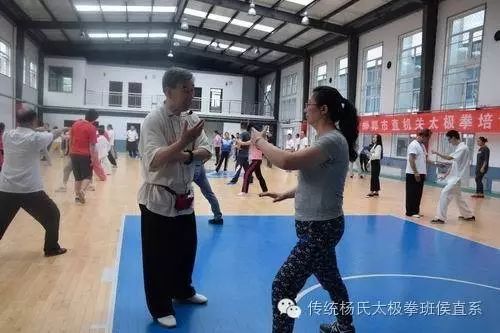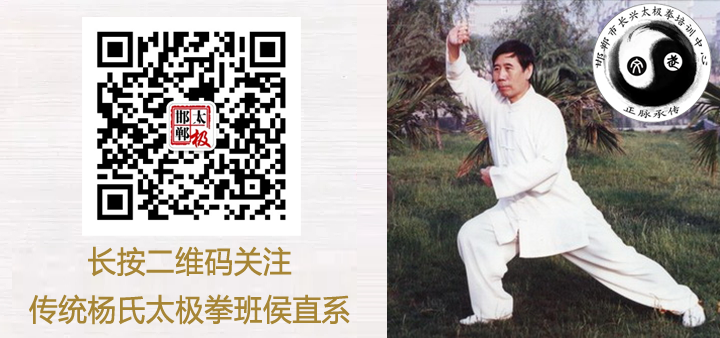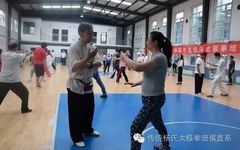Wu Yuxiang proposed in “Shisan Shi Shuo Lue” that “the distinction between empty and solid must be clear; there is emptiness and solidity in every part, and everywhere there is this one emptiness and solidity.” This is the earliest source for distinguishing between empty and solid in Tai Chi. Wang Zongyue’s “Tai Chi Chuan Lun” mainly discusses Tai Chi from the perspectives of hardness and softness, yin and yang, while Wu Yuxiang further deepened this by emphasizing the need to “distinguish between empty and solid.” Later, Li Yisha in “Wuzi Jue” further emphasized the theory of emptiness and solidity: “The strength of the body is cultivated as one family, distinguishing between empty and solid.” He also stated, “There must be a structured opening and closing, with clear emptiness and solidity.” To illustrate this, Li Yisha drew a diagram of the opening and closing of emptiness and solidity to further explain the concept in Tai Chi. The opening and closing of emptiness and solidity is a doctrine of Wu-style Tai Chi, which was later adopted by other Tai Chi styles such as Yang-style Tai Chi.What is emptiness and solidity? Emptiness refers to the internal aspect that cannot be seen externally; while opening and closing refer to the external movements. Emptiness is characterized by lightness and softness in movement; solidity is characterized by stability and strength, manifesting as firmness. This is my understanding of the opening and closing of emptiness and solidity. Next, I will focus on how to distinguish between emptiness and solidity in practicing Tai Chi.

First, practice the emptiness and solidity of the lower limbs. The lower limbs have three joints: the hip joint, knee joint, and ankle joint. The lower limbs mainly serve the purpose of advancing, retreating, and turning. In these movements, the hip, knee, and ankle joints must seek straightness within the bending, clearly distinguishing between emptiness and solidity. The leg bearing the body’s weight is the solid leg, while the other leg is the empty leg. The solid and empty legs change with the shift of the center of gravity. For example, in Wu-style Tai Chi’s left lazy tie, it starts in a Ding Ba stance, with about 60-70% of the body’s weight on the right leg, making it the solid leg, while the left leg plays a supportive role as the empty leg; then it transitions into a left bow stance, where the left leg becomes the solid leg and the right leg becomes the empty leg. This illustrates the change of emptiness and solidity in the left lazy tie movement concerning the legs. Here, it is important to ensure that the center of gravity rests on the Yongquan (Kidney 1) point of the solid foot, not on the heel or the ball of the foot.In the past, the elders said: “Without strength in Yongquan, the spirit has no master.” This means that if the Yongquan point lacks strength, one cannot root oneself and stand firm, leading to a lack of control over the spirit. Therefore, the Yongquan point of the solid leg must interact with the ground to create a pulling effect, ensuring stable footing. The other leg generally touches the ground with the ball or heel, serving a supportive role. Here, although the emptiness and solidity of both feet are clear, one must also achieve emptiness within solidity and solidity within emptiness. Li Yisha said: “Solid does not mean completely standing still; there is emptiness within solidity; emptiness does not mean completely lacking strength; there is solidity within emptiness.” Emptiness and solidity contain the potential for mutual transformation. Practicing Tai Chi requires that every part of the body embodies emptiness and solidity, which are constantly transforming into one another. This is the essence of emptiness within solidity and solidity within emptiness. This transformation of emptiness and solidity is primarily reflected in body movements, for which Wu Yuxiang proposed “tengnuo shanzhan,” emphasizing that the faster the changes between emptiness and solidity, the better.Secondly, after mastering the transformation of emptiness and solidity in the lower limbs, one must practice the changes in the upper limbs, distinguishing between the emptiness and solidity of the upper limbs. The upper limbs consist of the shoulder joint, elbow joint, and wrist joint, with the elbow joint being the most important, serving the function of bending, extending, rising, and lowering. In Tai Chi movements, regardless of whether the posture is simple or complex, it always involves these four actions: bending, extending, rising, and lowering. During the bending and extending actions, the shoulder, elbow, and wrist joints must seek straightness within the bending. How do we distinguish between emptiness and solidity in the upper limbs? Tai Chi is characterized by stillness in motion and motion in stillness, so distinguishing between emptiness and solidity must be primarily based on intention. For example, when both hands perform movements, one hand is high while the other is low, one is in front while the other is behind; regardless of whether one is softening or exerting force, the hand where your intention lies is the solid one, while the other hand is the empty one. Thus, the distinction of emptiness and solidity in the upper limbs is based on intention, which is applied according to the combat significance.Furthermore, after distinguishing the emptiness and solidity of the upper and lower limbs, one must practice the crossing of emptiness and solidity. For instance, if the left hand is solid, then the left leg must be empty; if the right hand is solid, then the right leg must be empty. One should avoid having both the right hand and right leg as solid or both as empty, as this would create imbalance. Tai Chi emphasizes balance and equilibrium. If the hands and feet on the same side are both solid or both empty, it leads to an imbalance, making the body unstable. Therefore, it is essential to achieve a crossing of emptiness and solidity between the hands and feet, ensuring stability of the center of gravity during practice.In practicing Tai Chi, if one can achieve the above three points, one can attain a clear distinction between emptiness and solidity. This is a broad perspective. In addition to these three points, one must also ensure that there is emptiness and solidity everywhere. For example, in the movement of “Luo Xi Ao Bu”: the left hand embraces the knee while the right hand strikes out; initially, the left hand is solid and the right hand is empty; once the left hand embraces the knee and the bow stance is formed, the left hand becomes empty and the right hand becomes solid; when the right hand moves forward, the fingers are solid while the palm root and wrist are empty; when settling into position, one must relax the wrist and extend the fingers, causing the palm to rise, making the Yujie (Lung 10) point of the right hand solid while other areas remain empty. To further improve in Tai Chi, one must not only distinguish between emptiness and solidity in broad terms but also practice the subtle changes of emptiness and solidity in finer details. These subtle changes are based on the combat significance of the movements. Such changes in emptiness and solidity are very rapid and diverse.The aforementioned discussion only covers the physical changes of emptiness and solidity; further practice involves the changes of internal strength regarding emptiness and solidity. This is what Wang Zongyue referred to in “Tai Chi Chuan Lun” as “sudden appearance and disappearance.” Emptiness represents the hidden, while solidity represents the visible. This kind of “sudden appearance and disappearance” in the changes of emptiness and solidity is entirely dependent on the practitioner’s level of skill and understanding of Tai Chi, reflecting the transformation of spirit and intention.Additionally, in push hands, one must also distinguish the changes of emptiness and solidity. Push hands is a training method for the changes of opening and closing of emptiness and solidity, which cannot be separated from the principle of Tai Chi: “Lead in and drop empty to combine and then strike out.”In this regard, Tai Chi summarizes two phrases: “Encounter force and yield, find gaps to enter.” This means that when encountering incoming force, one yields; if the opponent has a flaw, one attacks from that point, striking wherever possible. This is the requirement for the changes of emptiness and solidity in push hands.The changes of emptiness and solidity in free fighting are even more complex and cannot be easily summarized in a few sentences. However, fundamentally, it still revolves around the changes of opening and closing of emptiness and solidity. These changes are not fixed but adapt to the actual situation.

If there are any copyright issues, please contact the original author through the backend.The articles published are for learning and reference only.Please practice under the guidance of a professional teacher.

Official website: http://www.yunshuiwang.com



